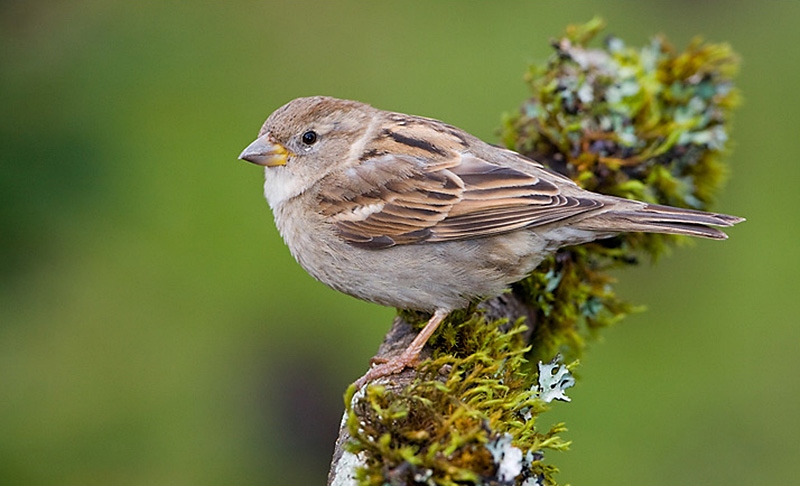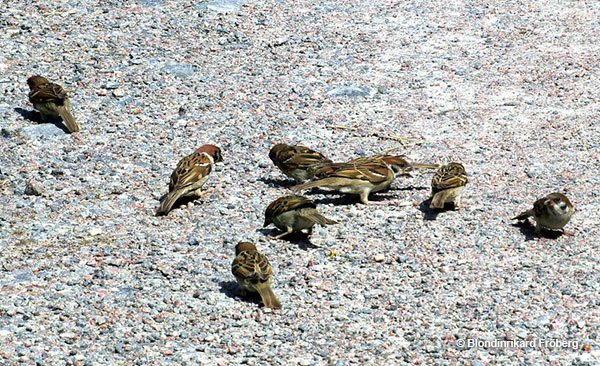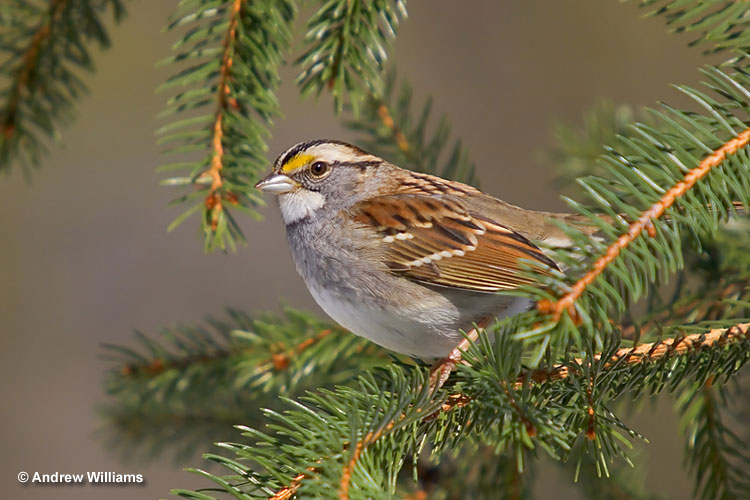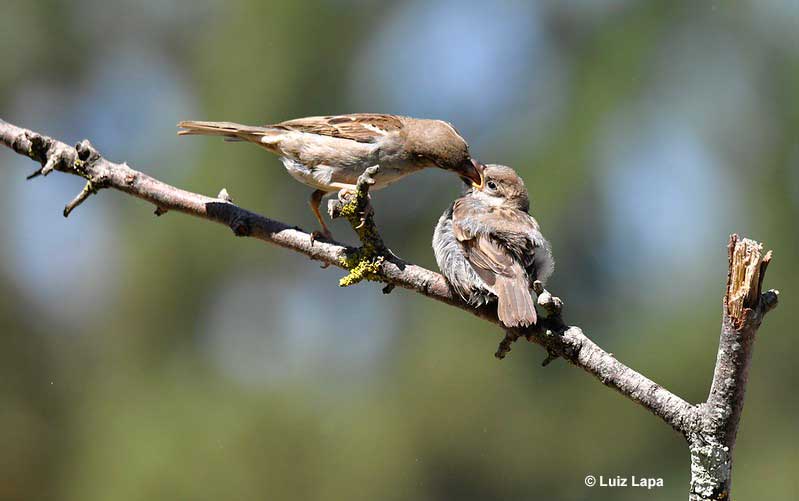
Sparrows are familiar little birds. Their constant presence outside our homes makes them easy to overlook.
Female sparrows, however, are often even more overlooked. By taking a closer look, you’ll find that some of the birds are duller, some make different vocalizations, or are slightly smaller.
So are female sparrows identifiable? What are their lives like? In this article, we’ve covered everything you need to know about female sparrows.
On this page
Female vs. Male Sparrows
The main differences between female and male sparrows are their plumage, size, and behaviors.
Related: 36 sparrow species in the U.S.
They’re similar enough that it can be easy to confuse them. When we see a group of these birds, whether they be House Sparrows, Tree Sparrows, or Rock Sparrows, females and males can look similar, if not the same.

Are they all males? Is there a female in this group? Looking at sparrows like this, it can be really difficult to identify them by gender.
Scientific Information
| Female Sparrow | Male Sparrow | |
| Size | Female sparrows tend to be smaller than male sparrows. A female sparrow is usually around 0.92 ounces. | Male sparrows tend to be a little bit bigger than female sparrows. A male sparrow is usually around 1.1 ounces. |
| Vocalizations | Female sparrows are a little bit more vocal than male sparrows. They produce the same single cheep notes but will also make short chattering sounds when their mate approaches or when driving away another female. | Male sparrows produce single cheep notes to express submissiveness within flocks or during courtship and copulation between pairs. |
| Behavior | Female sparrows share some behaviors with males but also have their own unique behaviors. Female sparrows are the ones to initiate the mating process; they exhibit territorial behavior around their nesting site and will not hesitate to defend their territory from other sparrows. Additionally, female sparrows are more tolerant of other sparrows than males. | Male and female sparrows share some behaviors but also have their own unique behaviors. Male sparrows don’t initiate the mating process; they exhibit territorial behavior around their nesting site and will not hesitate to defend their territory from other sparrows. Additionally, male sparrows are not very tolerant of other sparrows nearby. |
| Coloration | Female sparrows are duller than males and primarily have ash-brown plumage. | Male sparrows are brighter than females and have more contrasting colors. Their plumage showcases brown, black, and white. |
Duller Plumage
It’s essential to pay close attention to their appearance to distinguish between male and female sparrows. This can be a challenge due to their size and elusive nature. However, certain traits can aid in identification.
For example, male House Sparrows typically have gray plumage with bright brown feathers on their heads. Females, on the other hand, exhibit ashy brown shades with less brightness. Additionally, male House Sparrows have a lighter belly, and a black band can be seen on their throats.

Male sparrow is in the background, and can be identified by his darker plumage. Photograph © hedera.baltica
Female House Sparrows lack the lighter belly, and their throat color aligns with the brownish color of their bodies.
Male sparrows also have a black mask that surrounds their eyes. In some cases, this dark plumage reaches around their beaks and connects with a dark throat band.
Male sparrows have brighter and contrasting plumage, showcasing a mix of brown, black, and white, while females primarily display ash-brown shades.
Size Differences
Male and female sparrows are not the same size. Female sparrows tend to be a little bit smaller. However, when observing these birds in the wild, it’s difficult to see their size difference since it’s so minor.
A female sparrow is usually around 0.92 ounces, while a male sparrow is usually about 1.1 ounces. Sparrows can measure anywhere from 5.9 to 6.7 inches in length, have a wingspan ranging from 7.5 to 9.8 inches, and weigh anywhere from 0.9 to 1.1 ounces.
Behavior
Various sparrow species tend to exhibit the same behaviors, but we’ll focus on the White-throated Sparrow. These birds are commonly seen with others.
Both males and females engage in similar behaviors when foraging for food; they’ll hop around to search for birdseed, insects, food scraps, and grain. However, there are intriguing behavioral distinctions between male and female sparrows.
 Both female and male sparrows exhibit territorial behavior around their nesting site, and neither will hesitate to defend their territory from other sparrows. Female sparrows are the ones to chase away unwelcome females, while males take on the role of protecting from other males.
Both female and male sparrows exhibit territorial behavior around their nesting site, and neither will hesitate to defend their territory from other sparrows. Female sparrows are the ones to chase away unwelcome females, while males take on the role of protecting from other males.
When it comes to mating, male sparrows signal their intentions with an upright posture, an erect tail, and shivering wings that are lowered. Female sparrows exhibit a similar behavior. They’re the ones to initiate the process by crouching, lowering and shivering their wings, and pulling back their heads.
When it comes to personal space, female sparrows are less stringent than males. They are more tolerant of other females being in closer proximity compared to males allowing other males nearby. However, studies have shown tolerance decreases when the birds are hungry or cold.
How To Tell a Younger Sparrow’s Gender?
Differentiating between female and juvenile sparrows may present a greater challenge. Still, with an attentive observation of their throat, belly, and underparts’ coloration, you can tell whether you’re looking at a juvenile male or a female.
Juvenile male house sparrows generally exhibit darker tones on their lower parts, paler upper parts, and a lighter bill, which serves as distinguishing features.
Lifecycle
Sparrows commonly nest in holes in buildings and other structures. This could be roofs, streetlights, and poles. There have been some instances of these birds making nests in climbing vines along building walls. Moreover, sparrows like nest boxes; it’s not unheard of for them to displace current occupants so they can take over the nest box.
Sparrows make their nests primarily out of dry vegetation. They’ll stuff this course vegetation in the nesting cavity until it is almost entirely full.
They use finer materials like paper, string, and feathers for the lining. Interestingly, sparrows sometimes create nests next to each other. In some instances, nests even share walls.
Sparrows generally have up to 4 broods per breeding season, with anywhere from 1 to 8 eggs in the nest.
Female Sparrow – Frequently Asked Questions
What’s the difference between a male and female sparrow?
The main differences between male and female sparrows are their size, vocalizations, behaviors, and coloration. Female sparrows tend to be smaller than male sparrows, are a little bit more vocal than male sparrows, share some behaviors with males but also have their own unique behaviors, and are duller than males.
How many eggs do female sparrows lay?
Female sparrows lay anywhere from 1 to 8 eggs.
Do sparrows mate for life?
Yes, for the most part, sparrows mate for life. They’re monogomous birds that form lifelong bonds. They’re among the few birds that remain with the same partner and raise multiple young each breeding season. However, not all sparrows are not strictly monogamous.
Specific individuals will partake in what can be described as ‘extra-marital affairs,’ taking place outside the nesting site. It is estimated that up to 15% of sparrow chicks are nurtured by a male who is likely not their biological father.
Conclusions
Female and male sparrows are noticeably different. They have some distinct differences that can help you tell them apart.
Males are larger, less vocal, and more territorial. Females are smaller, more vocal, and tend to be a little less aggressive and territorial.
It’s not too hard to tell the gender of a sparrow as long as you know what to look for. With the information listed above, we hope you’ll have a better chance of identifying whether a sparrow is a male or a female.


